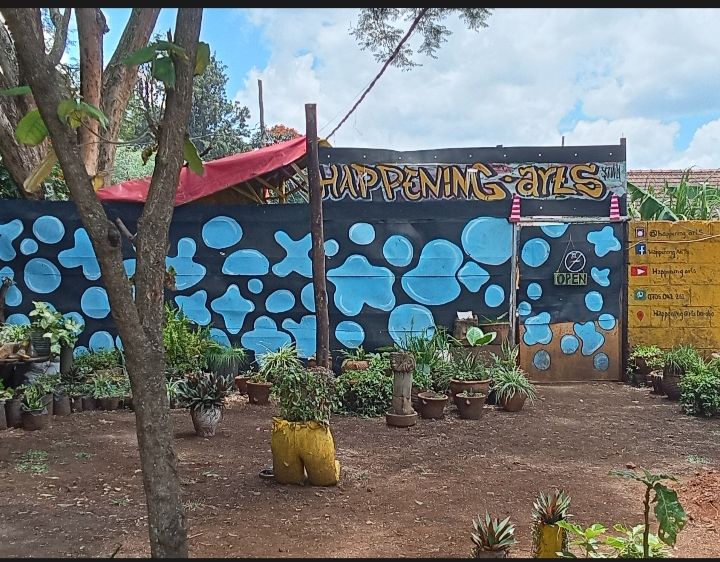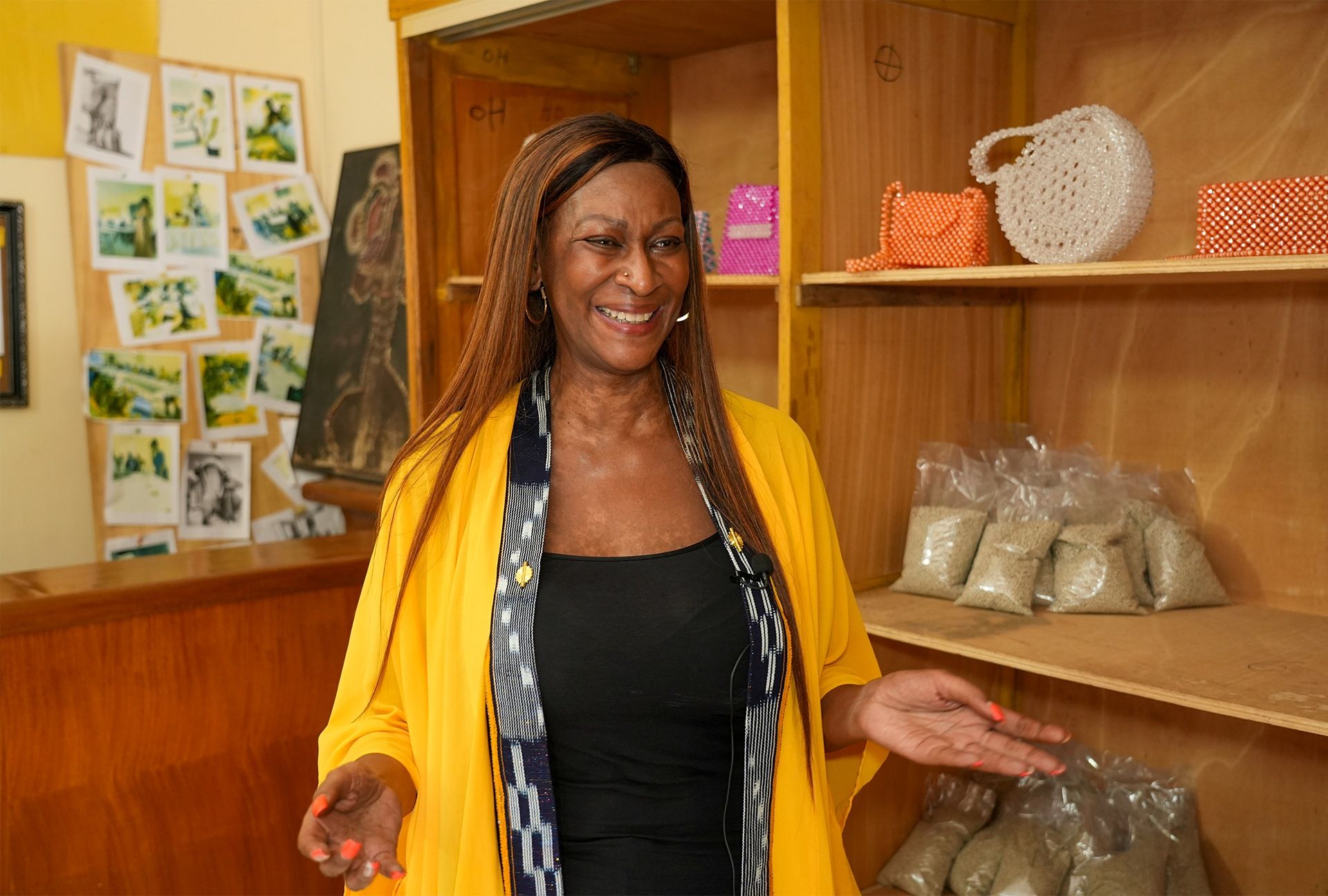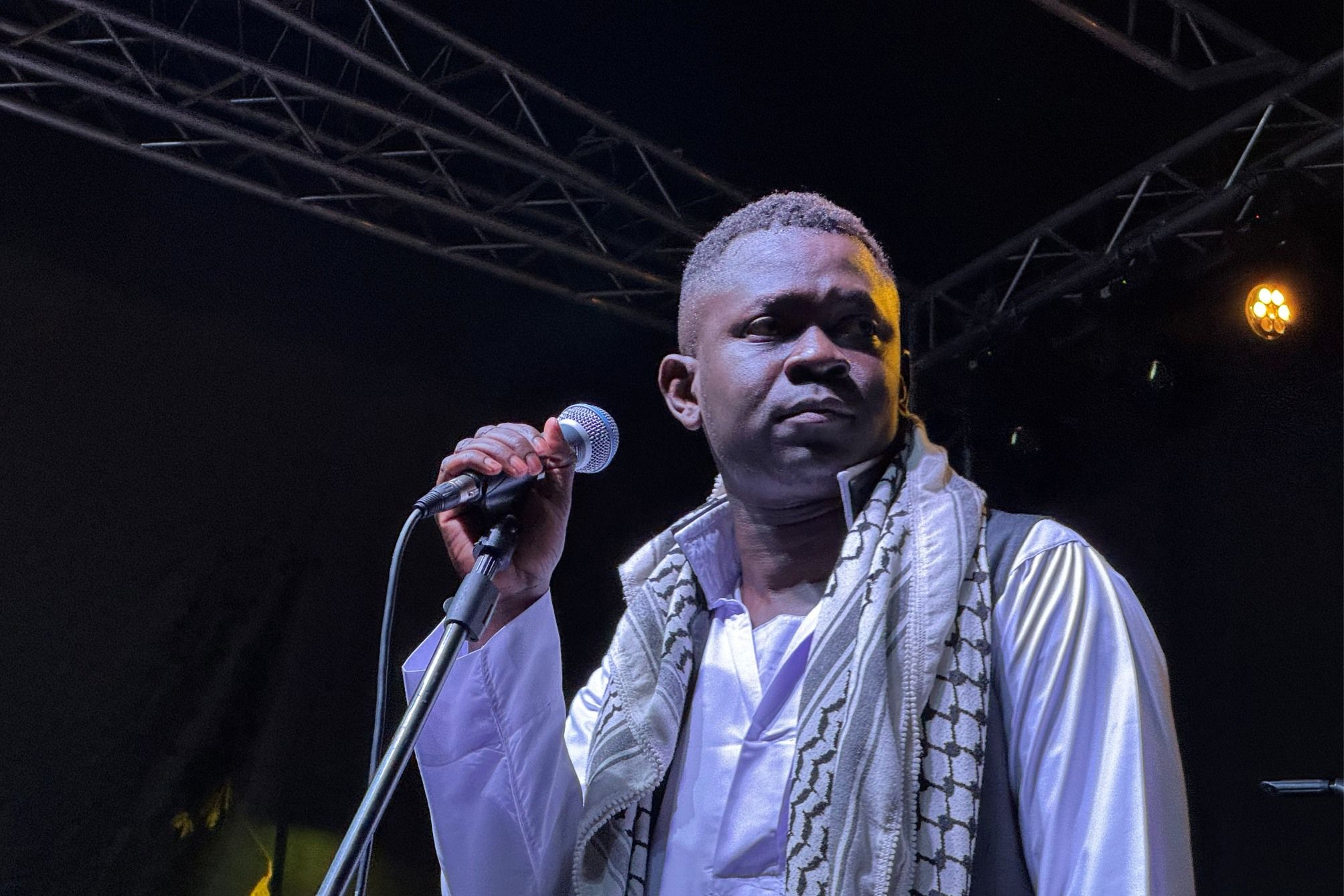Sequestered along Dorobo Road, the Happening Arts Community Centre doesn’t just appear. It unfolds and unfurls, slowly; first comes the potted spider plants, snake plants, Burros tails and stone carvings at its entrance then the hypnotic psychedelic graffiti on the entrance’s wall and if you make the mistake of pushing open its door, you are vehemently sucked into a vortex.

Once inside, you are entrapped in a veritable time machine where everything seems immobilised. There and then you’ll feel forces that you can’t quite put a finger on waft about. They are monumental, these forces. They hit you smack in the face throwing your head into a dizzying spin. They make your heart leap, before elevating your spirit then stretching it and for a moment you believe that anything is possible within those walls.
You will then close your eyes just to savour the moment, wishing that it would last forever. And when you open your eyes again and look at the ages-old Jacaranda trees above, the stump carvings around, and the murals, it will be revealed to you – by the very forces that had possessed you not too long ago – that you are in some sort of shrine, an art shrine. Here, creative forces coalesce with boundless imagination to bring forth art that distends the horizons.
Every shrine has its sangoma and one Simon Muturu happens to be the sangoma here at Happening Arts. Standing at 6ft 1, Simo – as he is fondly known – has deep-set eyes and a calm, almost imperceptible demeanour. He waltzes and hovers about subtly; one moment he is here, another he is there and the other he’s disappeared altogether. However, he is always there, at least in spirit if not in body, he always has been. In fact, the story of Happening Arts starts with him.

Forced by circumstances to drop out of school at Class 2 (what is now called grade 2) Simon Muturu became a street kid. For his meals, he would dig through restaurant bins or dumpsites for leftovers. At night, he’d snuggle together with his buddies under lorries or at street corners to keep the biting cold away. The older Simon and his compatriots grew, the more emboldened they became in their pursuit of other means of survival. They turned to pickpocketing hapless, unsuspecting Nairobi pedestrians.
“But I had seen pickpockets and petty thieves reduced to ashes in the streets. I promised myself not to meet the same fate,” says Simon. Instead, he turned to working as a car wash attendant in downtown Nairobi. “Sometimes, I would also assist motorists to park and reverse their cars at a modest fee,” he adds.
A senior driver at The Serena Hotel would notice his industry and offer him car washing gigs. While working car washing gigs at the Serena Hotel, the same senior driver who had roped him in challenged him to learn how to drive and acquire a driver’s licence. Seeing the opportunity, Simon saved up from his car washing gigs and paid what was then a princely sum of Ksh 8, 500 to obtain his driver’s licence in 2002. The doors of opportunity then flung open for him.
Again, the senior driver from Serena Hotel would be the amiable godfather, helping Simon get driving gigs every once in a while. “My life was shaping up in ways that I had never before imagined. With the driving gigs, my confidence and ability behind the wheel grew so much that I landed a job at a car hire company.”
With a good salary from his job at the car hire company, Simon turned to a life of hedonism. “I could single-handedly down a whole crate of beer in one sitting and smoke up to a whole pack of cigarettes a day,” he remorsefully says.
His Damascus moment would come in June of 2011 when realising that he had slumped into a comfort zone and acknowledging the destructive grip of the bottle, he made the decision to quit his job and overhaul his life. Then the sky came crashing down on him.
His wife died shortly after delivering their child and not too long thereafter, he inexplicably lost the little that he had built up during his years working as a driver. “I found myself back in the streets where I had started from,” he says with a sigh.
For the next six months, he was back to his old life; car washing gigs while trying to survive the cold streets. But not for long. Again, the trajectory of Simon’s life would change. One night the bush Simon and his friends were spending the night in caught fire and they had to flee. The morning following the fire tragedy, as Simon and his friends combed the area to try salvage any of their belongings Simon chanced upon a half-burnt tree stump. Out of curiosity and boredom, he tried to curve the root stump to give it shape. Impressed with his work, he took to carrying the curved root stump around as a memento. As luck would have it, Simon randomly stumbled into a pedestrian who took a curious interest in his curved tree stump and offered to buy it for Ksh 2,000. Spotting an opportunity, Simon became more deliberate in sourcing and curving out tree stumps for sale.

At the time, the parcel of land just opposite Nairobi Primary, on Dorobo road, and slightly past Klabu was a dumping site. Simon managed to convince the area chief to allow him to re-purpose the land and put up a workshop, a process which took all of six months. Consequently, Simon roped in his friends from the streets and tried to teach them how to curve tree stumps.
“For a time, between 2014 and 2016, I became disillusioned over the fact that the friends I had brought from the streets weren’t as dedicated to the craft as I had expected them to be. So I partially closed down the workshop,” Simon says with a tinge of pain in his voice.
The sun would however shine again on Simon’s little workshop in 2017 when he fully reopened it, and christened it Happening Arts.
Today, Happening Arts is a vibrant hub teeming with diverse artists; sculptors, muralists, visual artists, painters and even musicians. Serving as a creative haven, it doubles as a CBC centre, welcoming students from Nairobi Primary School and other neighbouring schools to embark on their projects under the guidance of resident artists. Moreover, Happening Arts is also a dynamic events venue, hosting art exhibitions, beauty pageants, pop-up markets, and music concerts.
“The main idea behind Happening Arts is sharing craft knowledge to cultivate independence and self-sustenance among the many creatives who frequent here. We want them to grow their art and possibly earn from it while also giving back to the communities they come from. In that way, we are helping create employment,” Simon says.
Simon believes that his biggest accomplishment with Happening Arts thus far is the fact that they have been able to give back to the community in multiple ways. Firstly, they repurposed land which was formerly a dumpsite posing environmental risks to the surrounding community. Simon is also proud that Happening Arts has given various artists a platform to hone and sharpen their talents and abilities. For example, Marlon, a musician and producer who has spent most of his formative years at Happening Arts.
“Happening Arts is like a second home for me. Sitting here refreshes and restores my creative energies. It is also here that I released my first music project. So it is in that sense that Happening Arts is really special and close to my heart,” Marlon says with a glint in his eyes.

Daniel Nuru, a muralist, and owner of the brand Onewalls is also among the group of multi-disciplinary artists working with Happening Arts. “I joined Happening Arts through Simon. I came in as an artist doing murals and biro pen art drawings. In July of 2023, we hosted a workshop where we worked with twelve artists to do the murals around the walls of Happening Arts,” Daniel says. He further adds, “I was warmly welcomed by the community here and readily helped in setting up events that promote environmental awareness through art and recycling. It has been impressive to witness how Happening Arts has grown into a hub for creatives to connect and collaborate in income-generating projects.”
Seeing as Happening Arts is also an events venue, I was curious to know their requirements for renting out the space to prospective event-holders. “The foremost requirement is that the events be oriented towards one form of art or the other. But that’s not enough. In addition to that, we are concerned with working with partners whose brands are passionate about giving back to the community, creating inspiration as well as passing on knowledge much more than generating profits. These are what we look for,” says Simon.
Keith Ang’ana’s Qwani – a youth initiative for promoting literature among the youth by giving young writers a platform to publish their works – is one of the organisations that has recently partnered with Happening Arts to hold events. “For the second half of 2023, we did four events at Happening Arts; two open mic sessions, a karaoke night and an Arts & Crafts event. Preparations were easy with Happening Arts. We just had to pay the fee and then they’d do the organisation themselves. Then again, our relationship with Simon has been really cordial which made working together easier,” says Keith.
Happening Arts also uses art as a conduit for promoting environmental awareness. To this end, they repurpose dumped glass bottles, clothes and other non-degradable materials to create flower vases or art items. Additionally, they also collect and nature tree seedlings which they use for their tree planting exercises. During the sit-down with Simon, he would explain that they had slated the rest of the day for a tree-planting exercise at Milimani Secondary School in conjunction with some students from the University of Nairobi.

“The larger goal for Happening Arts,” Simon explains, “Is to keep on sharing knowledge amongst each other and building on the reservoir of knowledge created to offer solutions. We are all from different backgrounds and geographical locations. If everybody shares knowledge from their place and we piece that together, then we would have something unique. Moreover, we want to cut dependency on the government for solving our problems. We don’t want to keep saying Serikali saidia all the time. We are constantly asking how we can better our lives using our gifts and talents while at the same time uplifting the communities we come from.”
Before letting Simon go, I ask him why he chose to name the place Happening Arts. He lets out a hearty laugh then pauses for a moment, lost in thought before jubilantly responding, “There’s always something artistic happening here all the time. So, Happening Arts!”




